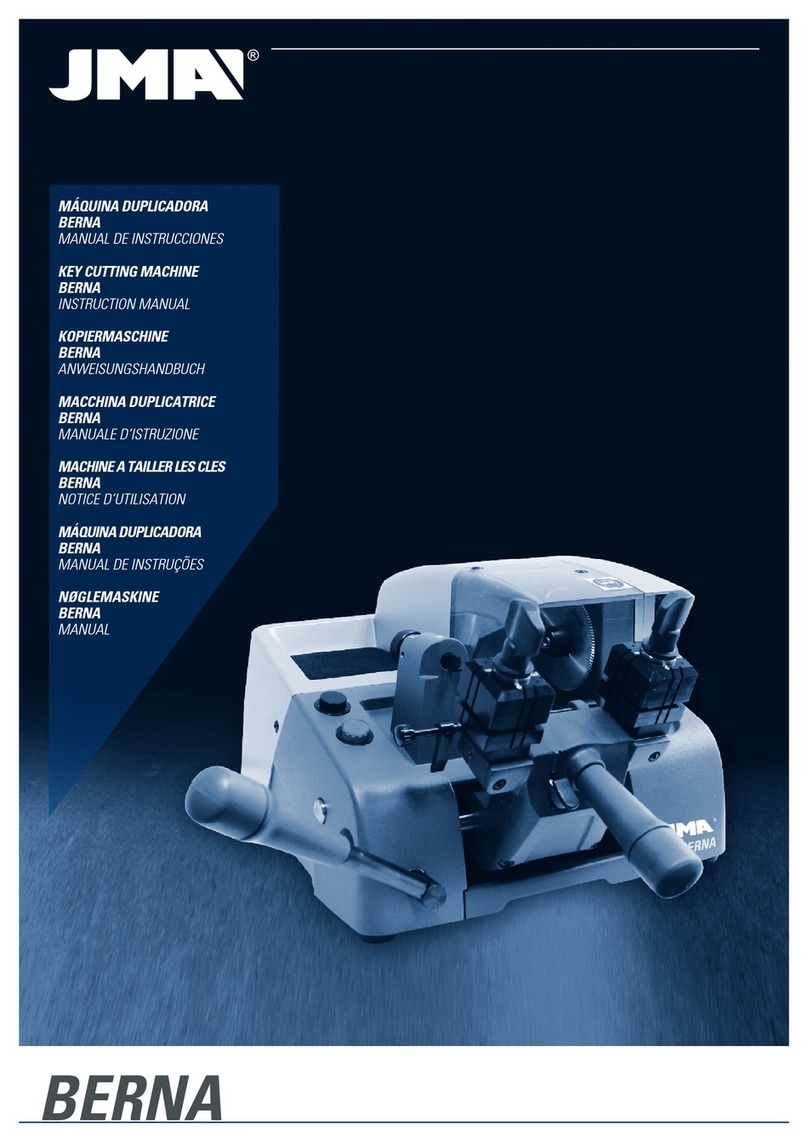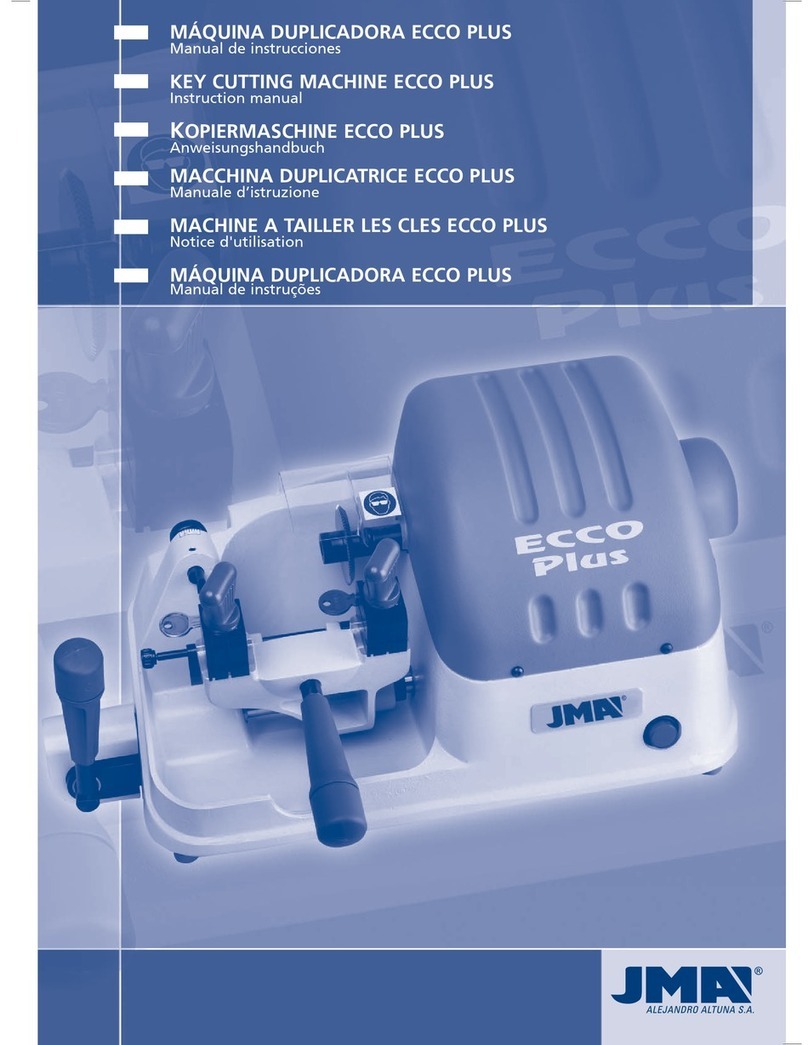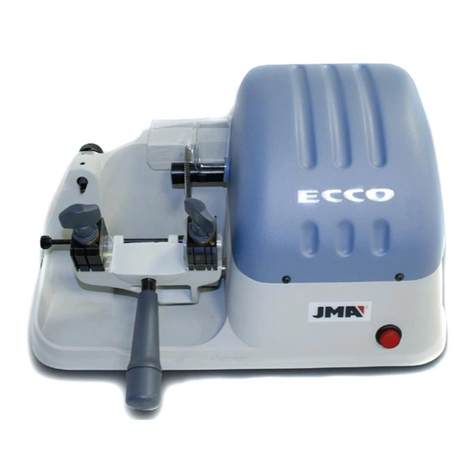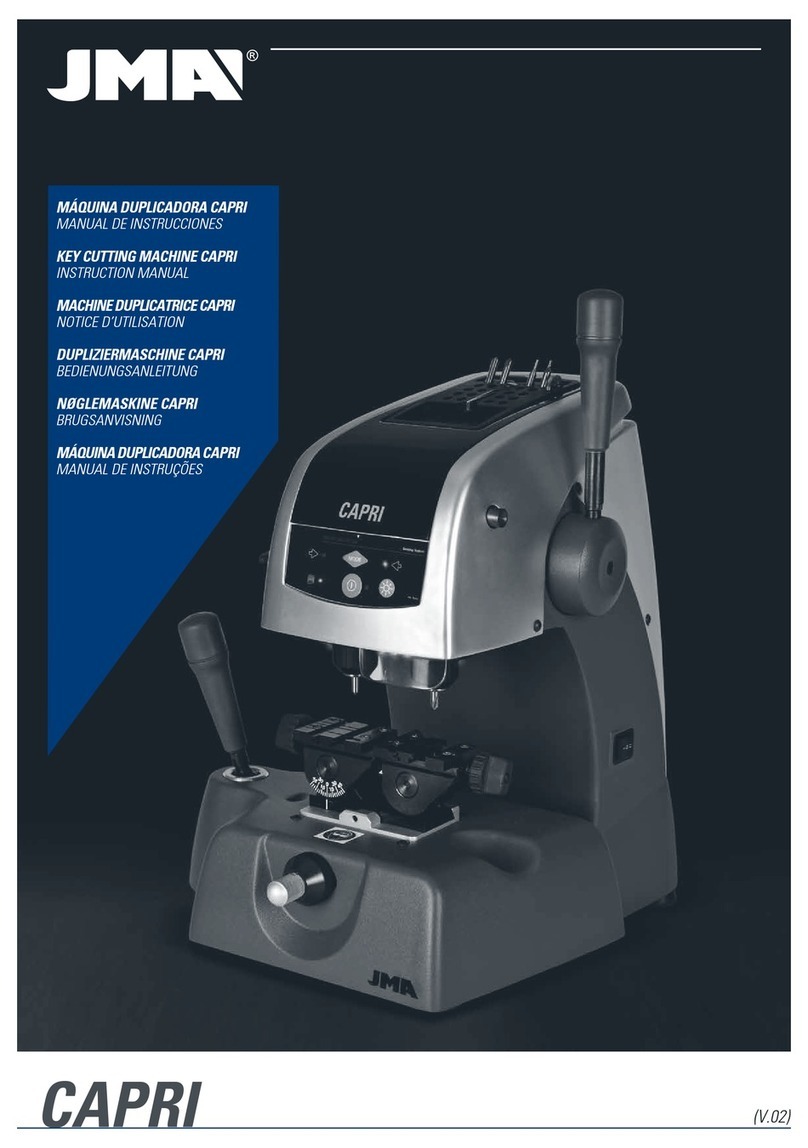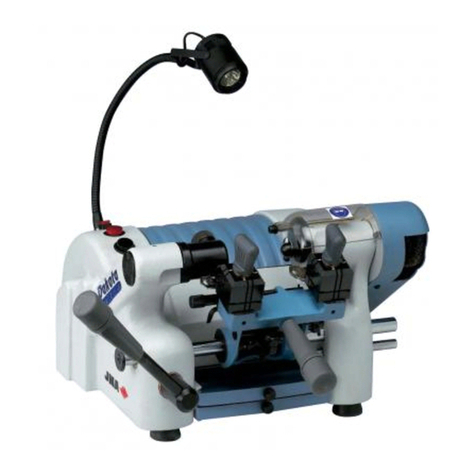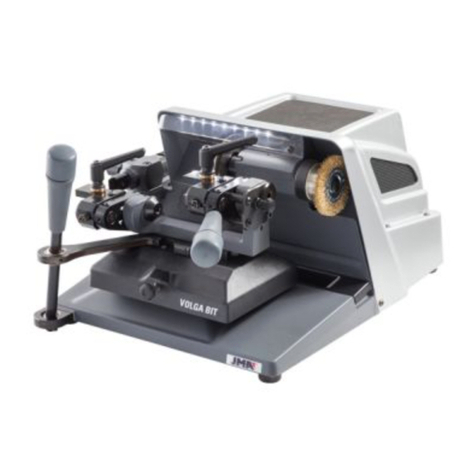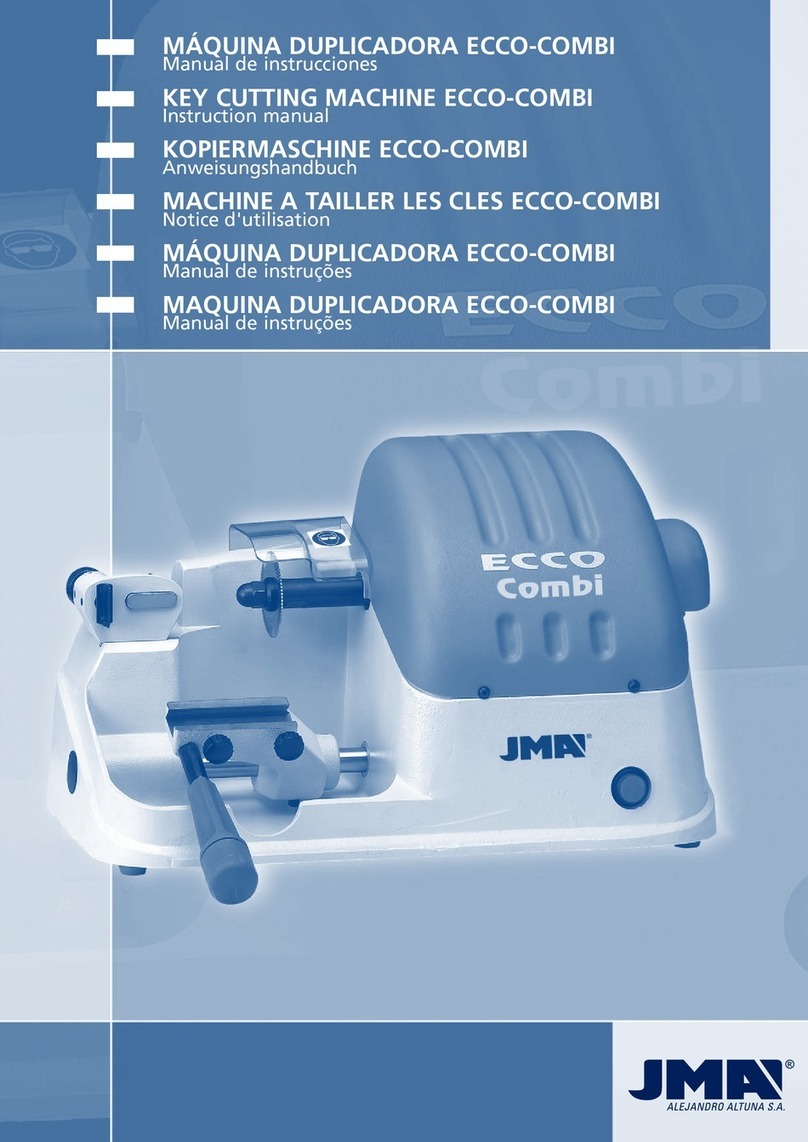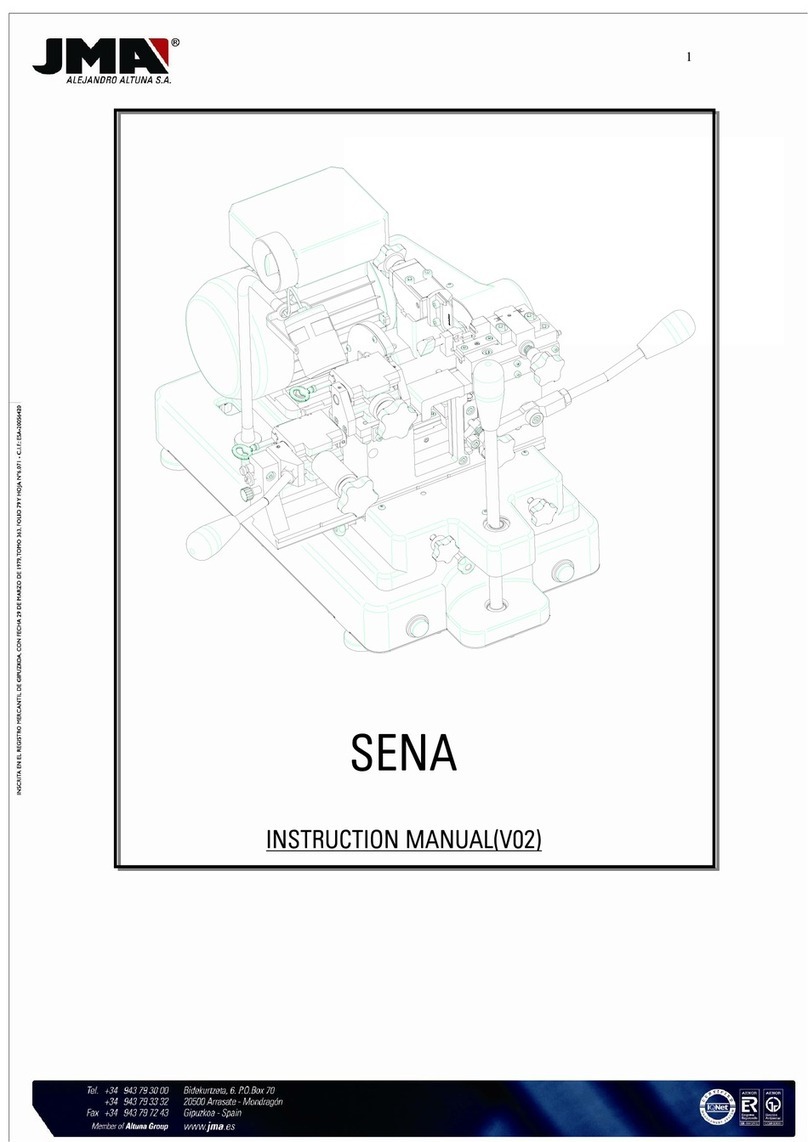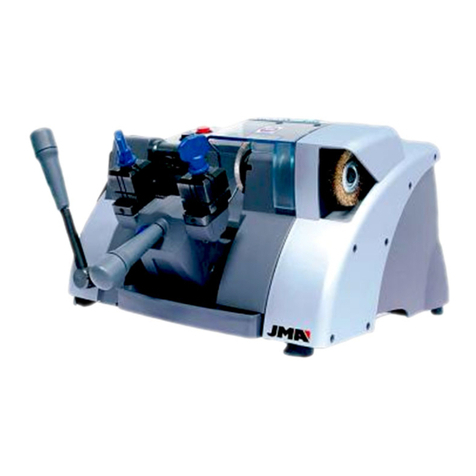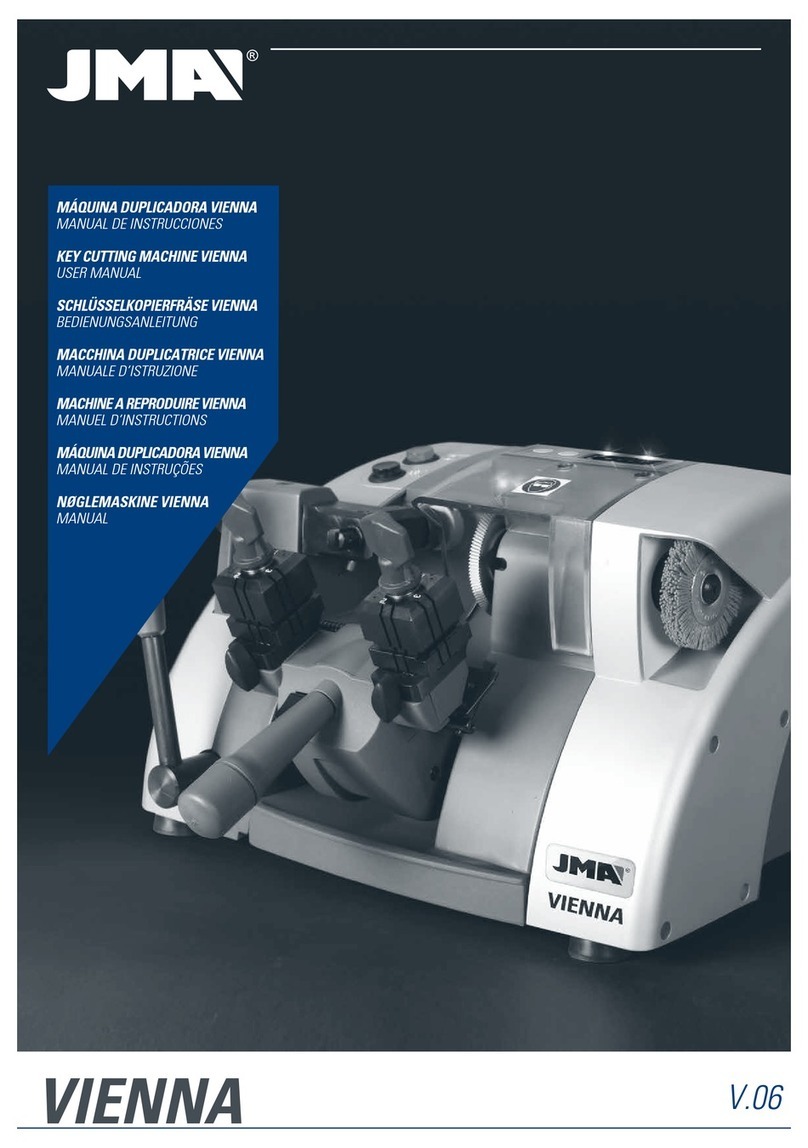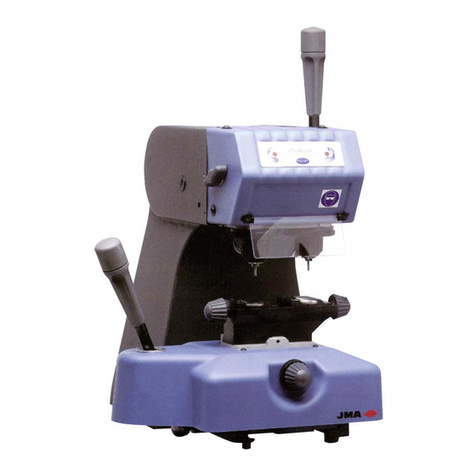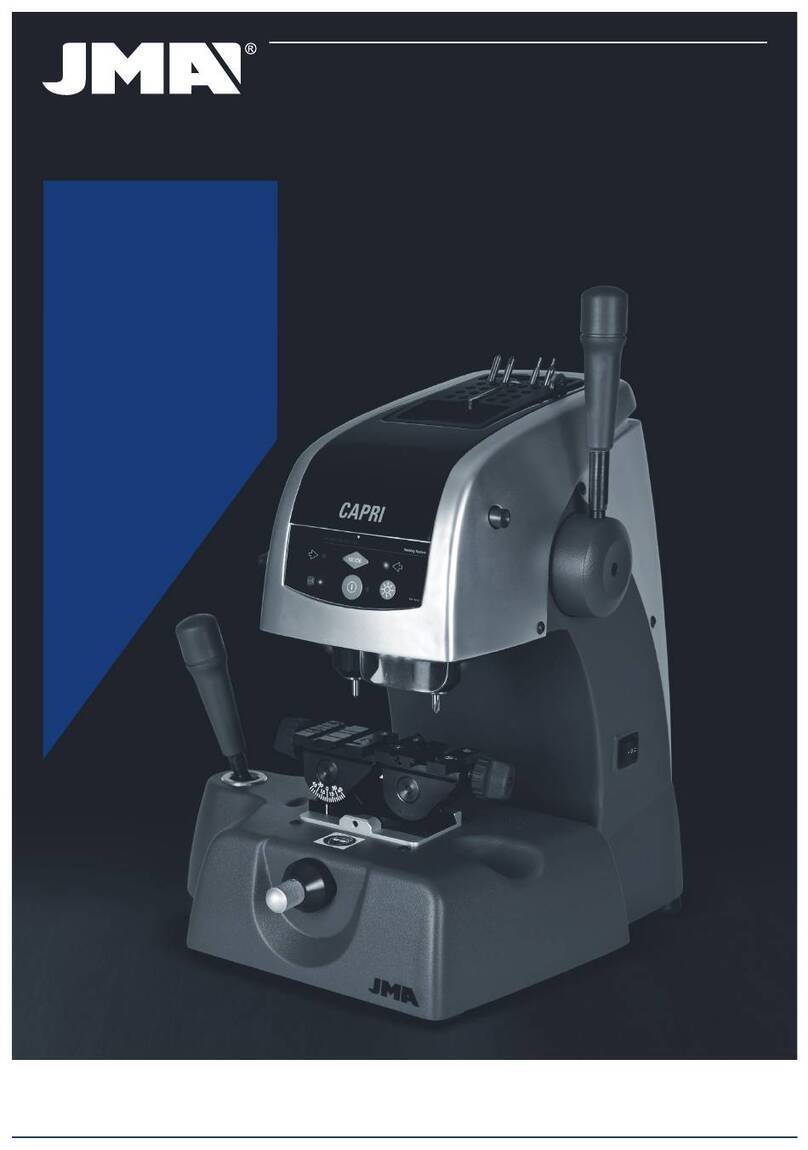
7
Español
Operación de duplicado de la llave
4.4
4.4.1 Operación de duplicado de la llave gorja
Introducir las llaves en las mordazas, teniendo cuidado de que el
paletón de la llave apoye sobre el tope interior de la mordaza.
Poner la máquina en marcha y sosteniendo el carro por medio
de la manilla (M), acercar las llaves hacia el índice copiador (I) y
la fresa (F).
Recomendamos que se ha de trabajar pausadamente, sin forzar
la fresa. El punto redondo se consigue, girando el carro porta-
mordazas con la manilla (N). El recorrido del punto redondo se
limita con el tope (P).
Si en el duplicado se han producido algunas rebabas en la llave
duplicada, éstas se eliminarán utilizando el cepillo, que para este
fin se ha dotado a la máquina.
La entrada de la fresa conviene hacerlo con la palanca (N) y
entrar en la llave hasta el fondo.
Ver Figura 15
4.4.2 Duplicado de la llave frontal
Introducir las llaves en las mordazas, teniendo cuidado de que el
paletón de la llave apoye sobre el tope frontal de la mordaza.
Poner la máquina en marcha y sosteniendo el carro por medio
de la manilla (M), acercar las llaves hacia el índice copiador (I) y
la fresa (F).
Recomendamos que se ha de trabajar pausadamente, sin forzar
la fresa. La perpendicularidad de corte se consigue orientando
el carro con la manilla (N).
Si en el duplicado se han producido algunas rebabas en la llave
duplicada, éstas se eliminarán utilizando el cepillo, que para este
fin se ha dotado a la máquina.
La entrada de la fresa conviene hacerlo con la palanca (N) y
entrar en la llave hasta el fondo.
Ver Figura 16
4.4.3 Duplicado de la llave FO-4P
Colocamos las mordazas de gorja en la posición (C), a continua-
ción, colocamos la llave de tal manera que el paletón se asiente
sobre el rebaje de 45 o que tiene la mordaza en su lateral, así, le
damos los grados de inclinación al dentado de la llave.
Le hacemos a la llave tope de punta, fresa-palpador y procede-
mos al dentado de la misma.
Importante: Antes de colocar las llaves en la mordaza verificar la
posición de las mismas. Las llaves salen de fábrica con un diente
en uno de sus paletones mecanizado.
Ver Figura 17
4.4.4 Duplicado de la llave gorja mediante tope punta
Tenemos la pieza denominada “Soporte de punta (A-B), cuya
función es la de agilizar la puesta en la mordaza de la llave
haciendo tope de punta cuando tenemos que mecanizar varias
llaves del mismo modelo.
Situando la pieza en la posición 2, colocamos la llave que vamos
a mecanizar de manera que el paletón de la llave choque con el
tope “B” de la pieza. A continuación retiramos la pieza (soporte
punta) a la posición inicial 1.
Procederemos a la colocación de la llave original y sin mover la
llave en bruto, las ajustamos de tal manera que el paletón de la
llave en bruto choque con la fresa (C) de la máquina y el paletón
de la llave original con el palpador (D).
A continuación procederemos a mecanizar esta primera llave.
Si tenemos que mecanizar una segunda llave, y sin mover la llave
original, con solo colocar el Soporte de Punta en la posición n.o 2
y haciendo que choque el paletón de ésta segunda llave a mecani-
zar con el tope “B” del “Soporte”, tenemos centradas las llaves sin
tener que hacer tope en fresa y palpador.
Ver Figura 18
4.4.5 Duplicado de la llave FO-6P
LA LECTURA DEL CÓDIGO DE LA LLAVE ORIGINAL
La llave original tiene 6 posiciones de duplicado, y para realizar
una lectura correcta de ésta, debemos coger la llave con la mano
izquierda, es decir, quedando el paletón de la llave a la derecha
de la cabeza de plástico negro, tal y como se indica en el dibujo.
Ver Figura 19
Las posiciones en el duplicado de la llave, corresponden a
combinaciones de 4 distintas alturas que ahora señalamos y
vamos a numerar:
1 2 3 4
La altura n.o1, nos indica que no se debe duplicar. La posición
n.o2 nos señala que hay un pequeño rebaje en la llave y que
cuando es algo mayor corresponde a la altura n.o3. La altura
n.o4 es el mayor de los rebajes de la llave.
Entonces cogeríamos la llave y marcaríamos las 6 posiciones, tal
y como señalamos a continuación en función de las distintas
alturas:
POSITION A B C D E F
INCLINATION 3 4 1 2 4 2
Una vez conocido el código de la llave a duplicar, se coloca la llave
en bruto en la mordaza, y colocando la pieza (L) en la posición 1, la
llave debe de quedar completamente plana tal que si acercamos
la llave a la fresa, esta debe hacer marca en el centro de la llave.
Ver Figura 20
De no ser así, se debe soltar el espárrago (H), y entonces centramos
la llave, y utilizamos la pieza (J) realizando el ajuste correcto.
La pieza (I) es la bola de código que tiene 6 letras, correspondien-
tes a las 6 posiciones.
La pieza (J) sirve para el reglaje vertical.
La pieza (K) se utiliza en el reglaje horizontal.
La pieza(L) sirve para dar las inclinaciones correctas a la llave, en
función de la posición a que corresponda.
Haremos un pequeño ejemplo con la lectura anterior:
POSITION A B C D E F
INCLINATION 3 4 1 2 4 2
Colocamos la pieza (L) en la posición superior 3, e introducimos el
palpador en la bola pieza I en la letra A y efectuamos el duplicado
correspondiente. Hacemos la misma operación con la altura 4,
introduciendo el palpador en la pieza I en la letra B y comiendo
con la fresa la altura correspondiente, y así sucesivamente hasta
las 6 posiciones.
Posteriormente haremos lo mismo con los 4 números inferiores
de la pieza (L), duplicando así, el otro lado de la misma cara de
la llave.
Para duplicar la otra cara de la llave, damos la vuelta a la misma,
y volvemos a realizar la misma operación, utilizando siempre el
mismo código, ya que la llave es simétrica, y por ello se mantiene
el mismo código.






